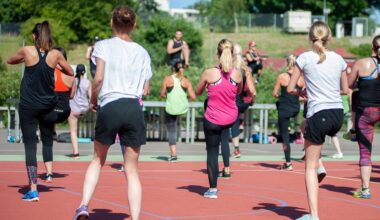Using Mobility Exercises to Prevent Muscle Imbalances and Injuries
The foundation of injury prevention greatly relies on flexibility and mobility training. Muscle imbalances occur when opposing muscles are not equally strong or flexible, leading to strain and injury. Engaging in mobility exercises can help correct these imbalances by promoting flexibility in muscles and joints. Regular participation in mobility training allows athletes and fitness enthusiasts to reinforce their movement patterns. Essential mobility exercises, like dynamic stretches and foam rolling, help dissipate tension in muscles. As tight muscles can restrict movement and lead to injuries, it is crucial to integrate these exercises into your training regimen. Emphasizing full range of motion is vital for maintaining flexibility around joints, minimizing the risk of injuries. Individuals seeking to enhance their performance should prioritize mobility alongside strength training. Implementing a mobility routine may not only prevent injuries but also improve overall physical efficiency. In addition to physical benefits, these exercises can contribute to mental relaxation, fostering better focus and concentration. By consistently practicing mobility exercises, individuals can work towards injury-free workouts and achieve their fitness goals effectively.
Understanding muscle mechanics is crucial in preventing injuries through mobility training. When muscles operate in harmony, they allow for smooth, efficient movement. In contrast, imbalances can cause poor movement patterns. Incorporating mobility exercises enhances proprioception, which is the awareness of body position in space. This increased awareness leads to improved coordination and body control. Proper techniques in mobility training can facilitate the elongation of shortened muscles, allowing for healthier movement patterns. This can be achieved through gentle static holds or controlled dynamic stretches aimed at tight areas. Establishing a dedicated mobility routine ensures that the body remains adaptable, accommodating various movement demands. Regular focus on these exercises carves out space for better joint health and overall well-being. Athletes often benefit greatly from consistent mobility work, as agility and responsiveness are improved. Additionally, this training allows for faster recovery after intense workouts. By preventing overuse injuries, mobility exercises contribute to sustained progress in performance. Therefore, whether as an athlete or a casual exerciser, embracing mobility can drastically transform one’s fitness journey.
Energizing Your Mobility Routine
To maximize the benefits of mobility work, developing an energizing routine is essential. Selecting exercises that target specific joints and muscle groups is key to ensuring effectiveness. Begin with dynamic stretches to promote circulation and prepare the body for movement. Exercises such as leg swings, arm circles, and hip openers increase blood flow, enhancing performance. As you progress, incorporate foam rolling to alleviate tension and stimulate the fascia surrounding muscles. Foam rollers are particularly effective for tight areas such as the calves, hamstrings, and quadriceps. Consistently practicing mobility drills such as the deep squat or thoracic spine rotation can promote greater flexibility. An adaptable routine can also meet individual needs while addressing personal goals. Finding effective progressive overload in your mobility regimen can enhance your flexibility and overall performance. Engaging in a supportive community focused on mobility training can create accountability. By sharing tips and experiences, you can further motivate others to prioritize their mobility routines. Additionally, keep your mobility sessions enjoyable to foster long-term commitment and incorporation into your lifestyle. Flexibility and fun can coexist, leading to injury prevention and strength gains.
Certain mobility trends have emerged as crucial for injury prevention as awareness grows. Among these, yoga and Pilates have surged in popularity due to their effective focus on muscle control and flexibility. Practicing these methods can enhance core strength, which supports proper posture and alignment during movement. Better posture minimizes the risk of injuries by promoting balanced muscle activation. Furthermore, incorporating functional mobility drills that mimic everyday activities can improve your resilience. Movements like lunges, squats, and reach variations can help develop body awareness and range of motion. These exercises facilitate injury prevention by preparing the body for dynamic activities. Understanding how to use mobility tools, such as resistance bands or balls, can add an effective dimension. These tools provide variable resistance, challenging the muscles more effectively. Additionally, integrating mobility sessions in your training routine can provide essential recovery for strength gains. Regular practice ensures the body remains primed for performance while warding off chronic injuries. As you progress, continuously evaluate your mobility routine to sustain its effectiveness throughout your fitness journey.
Adjustments for Individual Needs
Each individual’s body is unique, necessitating personalized mobility strategies. Assessing your own specific needs can determine the most beneficial exercises to incorporate. Working with a physical therapist or qualified trainer can provide tailored guidance to maximize recovery and mobility progress. If you’ve experienced past injuries, targeted mobility routines can support recovery while preventing further damage. Keeping an open dialogue with practitioners allows you to track your mobility journey over time. Additionally, balancing mobility work with strength training is vital for muscle imbalances and injury prevention. Implementing both modalities creates a synergistic effect, enhancing overall performance. Complementary exercises that strengthen weak muscle groups can serve as a form of injury prevention. Relying solely on one type of training can leave certain muscle groups susceptible to injury risk. Opting for a holistic approach that intertwines mobility, strength, and flexibility is recommended. Furthermore, staying consistent with your adapted mobility routine can lead to lasting benefits. Maintaining a well-rounded approach allows each session to reinforce injury prevention and physical health, fostering overall success in your fitness endeavors.
Additional strategies to enhance mobility training involve integrating recovery protocols into your routine. Prioritizing recovery can significantly impact muscle function and performance levels. Techniques such as contrast baths, proper hydration, and nutrition support recovery processes. Ample sleep is essential for muscle recovery and overall well-being since adequate rest promotes flexibility. Moreover, mindfulness practices, such as meditation or breathing exercises, can complement mobility routines. These strategies contribute to reducing stress and promoting relaxation in muscles. By embracing a multi-faceted approach that emphasizes mobility, strength, and recovery, participants can cultivate a sustainable fitness lifestyle. Individuals must remain aware of their body’s response to various workouts and adjust accordingly. Tracking progress and celebrating achievements can boost motivation and commitment. A supportive community can also amplify dedication towards mobility training. Sharing experiences and challenges in mobility-related forums can provide fresh insights and encouragement. It is vital to treat mobility as an ongoing journey rather than a one-time effort. Continuing to adapt and refine your routine ensures long-term benefits. By integrating these adjustments, you’ll foster resilience against injuries while progressing towards your fitness goals.
Conclusion
In conclusion, mobility exercises represent a fundamental component of injury prevention and enhancing overall physical performance. Recognizing the significance of flexibility training early in your fitness journey can save individuals from painful setbacks. These exercises address muscle imbalances and foster better movement patterns. Through consistent practice, participants can unlock their physical potential. Mobility work not only primed muscles for activity but also fosters recovery between intense workouts. Utilizing various techniques, including foam rolling, dynamic stretches, and yoga, can drastically enhance mobility. A comprehensive understanding of your individual needs allows for personalized training, making progress more meaningful. As knowledge of mobility training increases, athletes can synergistically combine it with strength training for optimal results. Consistently striving for progress leads to sustainable improvements in fitness levels while reducing the risk of injury. By embracing mobility-focused routines, individuals can remain active and vibrant throughout their fitness journeys. Creating a balanced approach that encompasses strength, flexibility, and proper techniques cultivates a lifestyle free from injury. Ultimately, mobility exercises are indispensable tools for achieving longevity and functionality, successfully realizing fitness aspirations.
Injuries often derail fitness pursuits, but with a commitment to mobility training, the risk can be significantly reduced. Utilizing proper tactics for muscle flexibility, mobility exercises are essential to prevent muscle imbalances effectively. These practices empower individuals to engage in healthier movement patterns. Consequently, taking advantage of mobility-based routines can lead to stronger overall athletic abilities. Therefore, make mobility training an integral part of your overall fitness approach. Acknowledging its importance is vital to achieving long-term success in maintaining an active lifestyle. The journey towards a more resilient body begins with dedicated mobility work, ensuring you not only prevent injuries but also enhance your physical aptitude. By establishing a routine centered around mobility exercises, your performance will flourish, enabling you to meet exciting fitness challenges with confidence. Paying attention to body signals can guide personal development and milestones. With resources like trainers and community support, you have everything needed to prioritize and enhance mobility. From the beginner to the seasoned athlete, mobility exercises are a foundational investment for anyone pursuing overall health and well-being.


